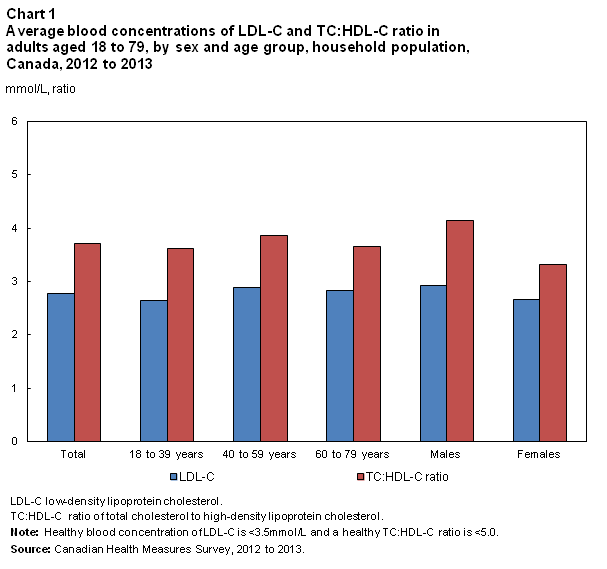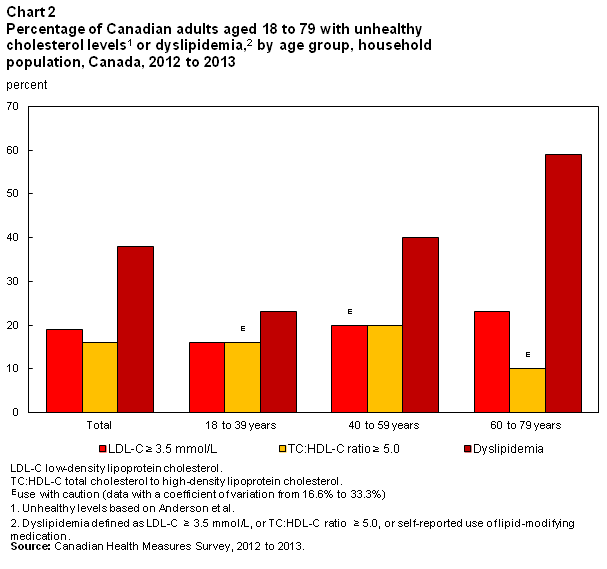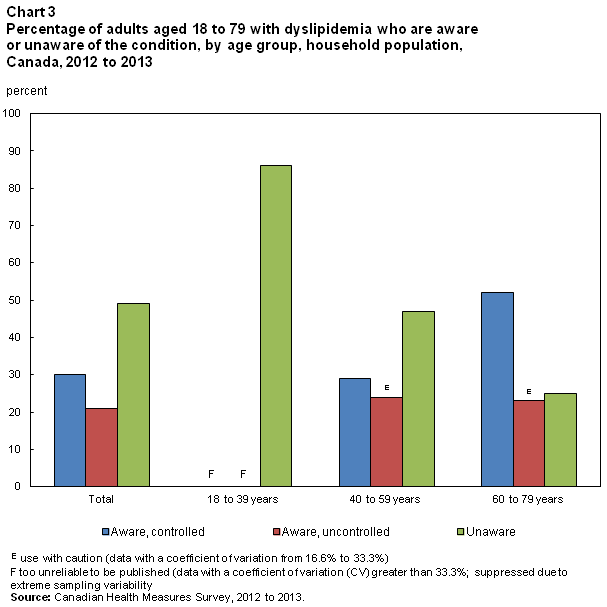Cholesterol levels of adults, 2012 to 2013
Archived Content
Information identified as archived is provided for reference, research or recordkeeping purposes. It is not subject to the Government of Canada Web Standards and has not been altered or updated since it was archived. Please "contact us" to request a format other than those available.

Cholesterol is an essential building block within the human body. The majority of cholesterol in the body is manufactured in the liver, and the rest comes from the food we eat. Unhealthy cholesterol levels, or dyslipidemia, can have negative effects on blood vessels and cardiovascular health, and is a significant risk factor for cardiovascular disease.Note 1
Average cholesterol levels
Results from the 2012 to 2013 Canadian Health Measures Survey (CHMS) indicate that for adults aged 18 to 79, the average blood concentration of low-density lipoprotein cholesterol (LDL-C) was 2.78 mmol/L (see About cholesterol). The average LDL-C for the 18 to 39 age group (2.64 mmol/L) was significantly lower than the 40 to 59 age group (2.89 mmol/L) (Chart 1). For high-density lipoprotein cholesterol (HDL-C), the average blood concentration was 1.38 mmol/L which was similar across all age groups (data not shown). The average total cholesterol to HDL-C ratio (TC:HDL-C) was 3.7 for adults aged 18 to 79. Those aged 40 to 59 had a significantly higher TC:HDL-C ratio (3.9) compared to those aged 60 to 79 (3.7) (Chart 1).

Overall blood cholesterol profiles differed significantly between males and females. LDL-C (2.66 mmol/L) and the TC:HDL-C ratio (3.3) were both lower in females compared to males (LDL-C: 2.93 mmol/L, TC:HDL-C ratio: 4.1)(Chart 1). HDL-C was higher in females (1.53 mmol/L) compared to males (1.23 mmol/L)(Data not shown).
It was determined that 19% of individuals aged 18 to 79 were living with unhealthy LDL-C levels and 16% of individuals were living with an unhealthy TC:HDL-C ratio (Chart 2). The 40 to 59 age group had a significantly higher percentage of individuals with an unhealthy TC:HDL-C ratio (20%) compared to the 60 to 79 age group (10%) (Chart 2).

With regards to sex differences, males (23%) had a higher percentage of individuals living with unhealthy LDL-C levels compared to females (16%) although the difference was not significant (data not shown).
Dyslipidemia
Dyslipidemia was defined as having unhealthy blood concentrations of LDL-C (≥3.5mmol/L), or a TC:HDL-C ratio ≥5.0, or self-reported use of a lipid-modifying medication. Dyslipidemia was measured or self-reported in 38% of individuals. The prevalence of dyslipidemia differed significantly with age. The prevalence of dyslipidemia was significantly lower for those aged 18 to 39 (23%) compared to those aged 40 to 59 (40%) and those aged 60 to 79 (59%). Dyslipidemia in the 40 to 59 age group was also significantly lower than in the 60 to 79 age group (Chart 2).
Among individuals with dyslipidemia, a total of 51% were aware of their condition (reported being diagnosed with an unhealthy cholesterol level by a health care professional or taking medication). Among those who were aware, 30% had controlled blood cholesterol levels while 21% were measured as having unhealthy LDL-C levels or a total cholesterol to HDL-C ratio consistent with dyslipidemia (Chart 3). Those aged 40 to 59 had a significantly lower percentage (29%) of individuals who were aware with controlled blood cholesterol levels compared to the 60 to 79 age group (52%). Those aged 18 to 39 had a significantly higher percentage (86%) of individuals who were unaware of their condition compared to both those aged 40 to 59 (47%) and 60 to 79 (25%). The 40 to 59 age group was also significantly more unaware than the 60 to 79 age group.

Start of text box
About cholesterol
Cholesterol is a building block that is vital to human health. It plays an important role in the structure of our cells in addition to helping produce vitamin D and various hormones.Note 1 There are two main molecules related to cholesterol to consider, and each can have a very different effect on cardiovascular health. Low density lipoproteins transport cholesterol within the blood stream and deposit it in the walls of arteries creating plaque. This is considered the “bad” because an accumulation of plaque on the arterial wall causes an increased risk of cardiovascular disease. In contrast, the high density lipoproteins are considered “good” because they remove cholesterol from the bloodstream and transport it to the liver. They minimize the creation of plaque and reducing the risk for cardiovascular disease.Note 1,Note 3 The ratio of total cholesterol to high density lipoprotein cholesterol (TC:HDL-C) is also commonly used to assess a person’s cardiovascular risk because it is an indicator of the amount of “good” cholesterol relative to the amount of total cholesterol.Note 2 Certain people are at a higher risk of cardiovascular disease and thus require greater monitoring of cholesterol levels. These individuals include males aged over 40 and females over 50, menopausal females, people with diabetes, atherosclerosis, abdominal obesity, high blood pressure and people who smoke or have a family history of cardiovascular disease.Note 2 In some cases, cholesterol levels can be improved through proper diet and exerciseNote 4 but may also need to be supplemented with certain medications.Note 5
The CHMS measured the concentrations of HDL-C and total cholesterol in serum which is a component of blood (in millimoles per litre - mmol/L) on a nationally representative sample. LDL-C in blood (mmol/L) was calculated using the Friedewald equationNote 6 for a selected fasted subsample of respondents who had fasted for at least 10 hours prior to the blood draw.
Respondents were also asked to report if they have ever been diagnosed, by a health care professional, with high cholesterol. Respondents also self-reported medications taken in the past month. Any self-reported medication determined to be a “lipid-modifying agent” (according to the Anatomic Therapeutic Classification system) was used to identify respondents being treated for unhealthy blood cholesterol.
End of text box
Notes
References
Anderson, T., Grégoire, J., Hegele, R., et al. 2013. “2012 update of the Canadian Cardiovascular Society guidelines for the diagnosis and treatment of dyslipidemia for the prevention of cardiovascular disease in the adult.” Canadian Journal of Cardiology. Vol. 29, p. 151 to 167.
Castelli, W.P. 1988. “Cholesterol and lipids in the risk of coronary artery disease – the Framingham Heart Study.” Canadian Journal of Cardiology. Vol. 4, Supplement A, p. 5A-10A.
Friedewald, W., Levy, R., and D. Fredrickson. 1972. “Estimation of the concentration of low-density lipoprotein cholesterol in plasma, without use of the preparative ultracentrifuge.” Clinical Chemistry. Vol. 18.
Ministry of Health and Long Term Care. 2013. Lowering your cholesterol through diet and lifestyle. Toronto: Ministry of Health and Long Term Care. http://www.mhp.gov.on.ca/en/healthy-eating/cholesterol.asp. Accessed: August 12, 2014.
Ottawa Heart Institute. Lipid Clinic. Ottawa: University of Ottawa Heart Institute. http://www.ottawaheart.ca/patients_family/lipid-clinic.htm. Accessed: August 12, 2014.
Toth, P.P. 2008. “When high is low: raising low levels of high-density lipoprotein cholesterol.” Current Cardiology Reports. Vol. 10.
Data
Additional Canadian Health Measures Survey data on this topic are available from CANSIM table 117-0008.
For more information on the Canadian Health Measures Survey, please contact Statistics Canada's Statistical Information Service (toll-free 1-800-263-1136; 514-283-8300; infostats@statcan.gc.ca).
Aussi disponible en français.
- Date modified:
